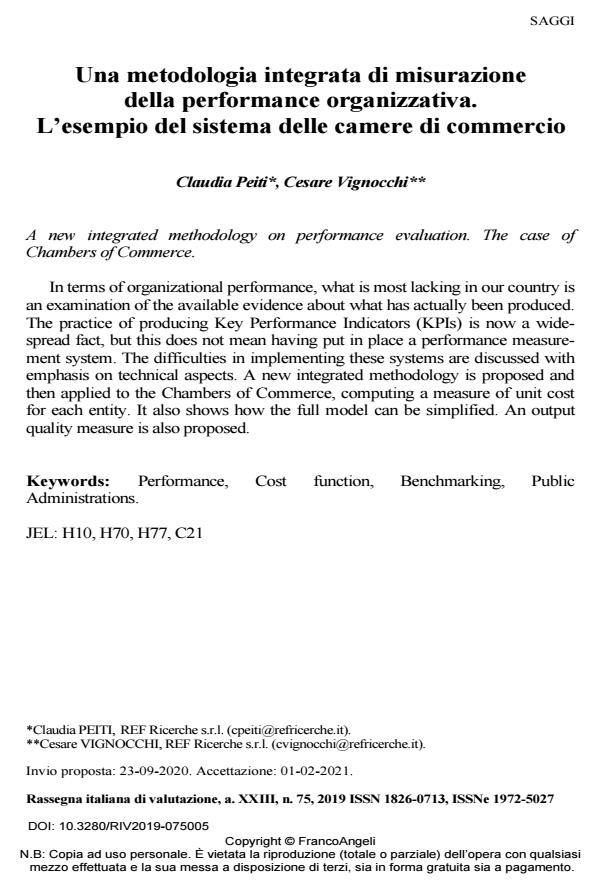A new integrated methodology on performance evaluation. The case of Chambers of Commerce
Journal title RIV Rassegna Italiana di Valutazione
Author/s Claudia Peiti, Cesare Vignocchi
Publishing Year 2021 Issue 2019/75 Language Italian
Pages 27 P. 60-86 File size 527 KB
DOI 10.3280/RIV2019-075005
DOI is like a bar code for intellectual property: to have more infomation
click here
Below, you can see the article first page
If you want to buy this article in PDF format, you can do it, following the instructions to buy download credits

FrancoAngeli is member of Publishers International Linking Association, Inc (PILA), a not-for-profit association which run the CrossRef service enabling links to and from online scholarly content.
In terms of organizational performance, what is most lacking in our country is an examination of the available evidence about what has actually been produced. The practice of producing Key Performance Indicators (KPIs) is now a widespread fact, but this does not mean having put in place a performance measurement system. The difficulties in implementing these systems are discussed with emphasis on technical aspects. A new integrated methodology is proposed and then applied to the Chambers of Commerce, computing a measure of unit cost for each entity. It also shows how the full model can be simplified. An output quality measure is also proposed.
Keywords: Performance, Cost function, Benchmarking, Public Administrations.
Jel codes: H10, H70, H77, C21
- Barabaschi N., Parlato S., Peiti C., Vignocchi C., (2014), “Estimate of standard expenditure needs. The example of the register office", Rivista italiana degli economisti, vol.XIX, n.3: 353-391.
- Beato G. e A. Zucaro A., (2014), “Un approccio di sistema ai metodi della valutazione”, in: Dell’Aringa C. e Della Rocca G., (a cura di), L’eccellenza nelle Pubbliche Amministrazioni. Valutare oltre gli adempimenti formali, Roma, AREL.
- Bonaretti M., (2014), contributo in: Riforma e valutazione della dirigenza pubblica, Seminari AREL, 2014.
- Boyne G., James O., John P., Petrovsky N., (2010) in: Hood C., Margetts H., Perri 6 (a cura di), Paradoxes of Modernization. Unintended Consequences of Public Policy Reform, , Oxford University Press.
- Dell’Aringa C. e Della Rocca G., 2014, (a cura di), L’eccellenza nelle Pubbliche Amministrazioni. Valutare oltre gli adempimenti formali, AREL.
- Dente B., Vecchi G., (1999), “La valutazione ed il controllo strategico”, in: Azzone G. e Dente B., (a cura di), Valutare per governare, ETAS, RCS Libri.
- Dente B., (2006), “Analisi delle politiche pubbliche e valutazione”, Rassegna italiana di valutazione, a. X, n. 34: 101-106.
- Dipartimento della Funzione pubblica, Linee guida per il Piano della performance. Ministeri, N. 1, Giugno 2017 e N.2, Dicembre 2017.
- Gertler P.J, Martinez S, (2011), Impact evaluation in practice, The World Bank.
- Gray D., Micheli P., Pavlov A., (2015), Measurement Madness. Recognizing and avoiding the pitfalls of performance measurement, Wiley.
- IFEL, (2016), Capacità fiscali e fabbisogni standard: la nuova perequazione comunale per il 2017, Studi e Ricerche.
- Lockwood B., Porcelli F., (2013), “Incentive Schemes for Local Government: Theory and Evidence from Comprehensive Performance Assessment in England”, American Economic Journal. Economic Policy, 5(3): 1-36.
- Khandker S.R., Koolwal G.B., Samad H.A. (2010), Handbook on impact evaluation: quantitative methods and practices, The World Bank.
- OECD, (2008), Handbook in Constructing Composite Indicators.
- Pastorello G., (2015), “La valutazione della performance individuale”, in: Dell’Aringa C., Della Rocca G. (eds.), L’eccellenza nelle pubbliche amministrazioni. Valutare oltre gli adempimenti formali. AREL, Roma.
- Pastorello G., (2017), “Ambivalenze della valutazione individuale. Vie di uscita”, in: Dell’Aringa C., Della Rocca G. (eds.), Lavoro pubblico fuori dal tunnel? Retribuzioni, produttività, organizzazione. AREL, Roma.
- Patton M.Q., (1997), Utilisation-focused Evaluation, Sage, Thousand Oaks.
- Reschovsky A., (2007), “Compensating Local Governments for Differences in Expenditure Needs in Horizontal Fiscal Equalization Program”, in: Boadway R., Shah, A., (a cura di). Intergovernmental fiscal grants: Principles and practice, The World Bank.
- Scaletta A., (2020) Video-lezioni realizzate per il progetto FP-CGIL a cura del Forum PA
- Scaletta A., (2017) “Per valutare la performance ci vuole pluralismo”, Risorse Umane n. 4-5: 9-15.
- Sestito P., (2014), “Dalla retorica alla pratica della valutazione: riflessioni per una ripartenza”, in: Carlo Dell’Aringa e Giuseppe Della Rocca, (a cura di), L’eccellenza nelle Pubbliche Amministrazioni. Valutare oltre gli adempimenti formali, Roma, AREL. Sestito P., (2017), “Carriera, incentivi e ruolo della contrattazione collettiva”, in Dell’Aringa C., Della Rocca G. (eds.), Lavoro pubblico fuori dal tunnel? Retribuzioni, produttività, organizzazione. AREL, Roma.
- Shah A., (2012) “Public services and expenditure need equalization: reflections on principles and worldwide comparative practices”. Policy Research Working Paper Series n. 6002, The World Bank.
- Van Dooren W., Bouckaert G., Halligan J.(2015), Performance Management in the Public Sector, Routledge.
- Vignocchi C., (2020), Wage Regulation and Performance Related Pay in Italian Public Sector, Rivista Internazionale di Scienze Sociali, n.1: 125-143.
Claudia Peiti, Cesare Vignocchi, Una metodologia integrata di misurazione della performance organizzativa. L’esempio del sistema delle camere di commercio in "RIV Rassegna Italiana di Valutazione" 75/2019, pp 60-86, DOI: 10.3280/RIV2019-075005